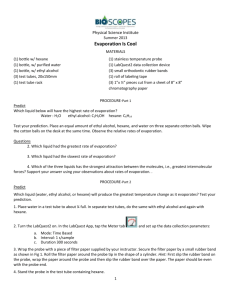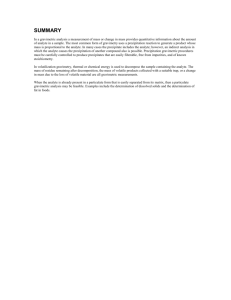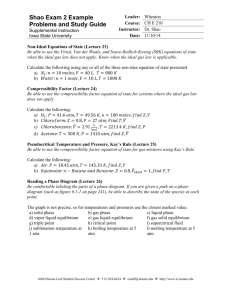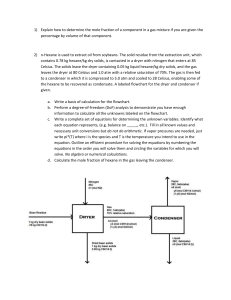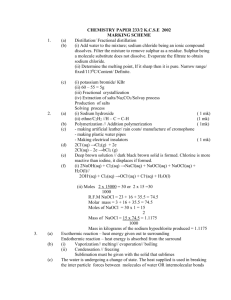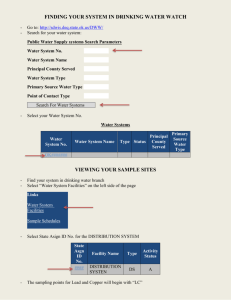5991-1808EN - Agilent Technologies
advertisement
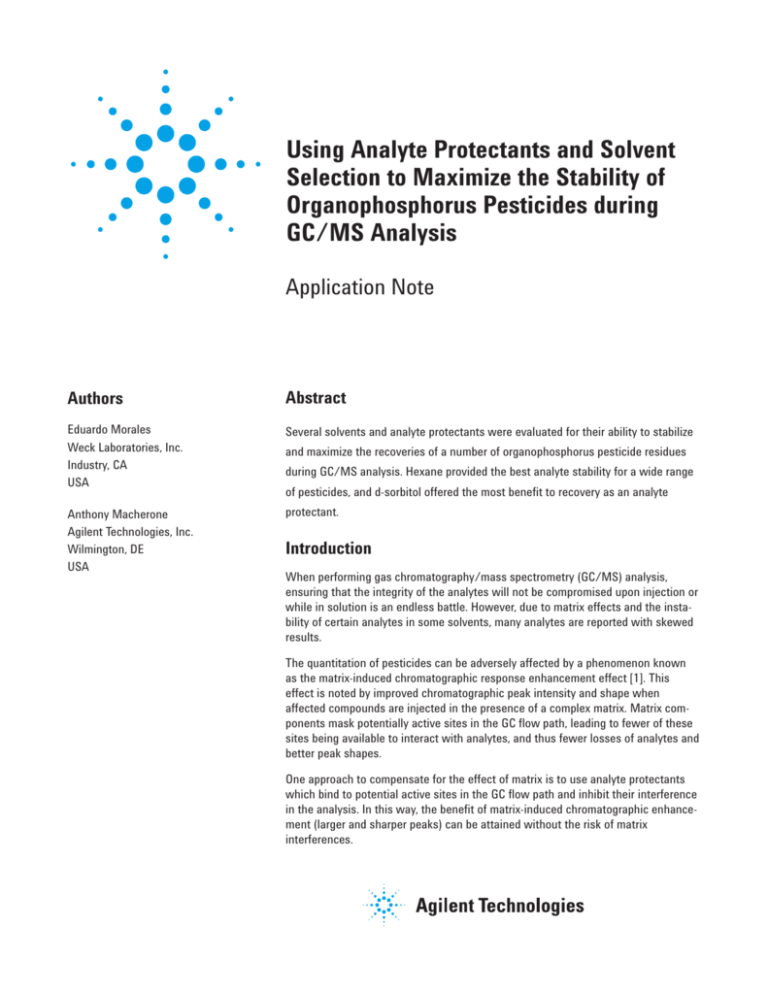
Using Analyte Protectants and Solvent Selection to Maximize the Stability of Organophosphorus Pesticides during GC/MS Analysis Application Note Authors Abstract Eduardo Morales Weck Laboratories, Inc. Industry, CA USA Several solvents and analyte protectants were evaluated for their ability to stabilize Anthony Macherone Agilent Technologies, Inc. Wilmington, DE USA and maximize the recoveries of a number of organophosphorus pesticide residues during GC/MS analysis. Hexane provided the best analyte stability for a wide range of pesticides, and d-sorbitol offered the most benefit to recovery as an analyte protectant. Introduction When performing gas chromatography/mass spectrometry (GC/MS) analysis, ensuring that the integrity of the analytes will not be compromised upon injection or while in solution is an endless battle. However, due to matrix effects and the instability of certain analytes in some solvents, many analytes are reported with skewed results. The quantitation of pesticides can be adversely affected by a phenomenon known as the matrix-induced chromatographic response enhancement effect [1]. This effect is noted by improved chromatographic peak intensity and shape when affected compounds are injected in the presence of a complex matrix. Matrix components mask potentially active sites in the GC flow path, leading to fewer of these sites being available to interact with analytes, and thus fewer losses of analytes and better peak shapes. One approach to compensate for the effect of matrix is to use analyte protectants which bind to potential active sites in the GC flow path and inhibit their interference in the analysis. In this way, the benefit of matrix-induced chromatographic enhancement (larger and sharper peaks) can be attained without the risk of matrix interferences. Some pesticides are also not stable in some of the common extraction solvents. For example, certain organophosphorus pesticides stored in ethyl acetate solutions were seen to degrade over long periods of time and elevated temperatures [2, 3]. Table 1. Agilent 7890A/7000B Gas Chromatograph and Triple Quadrupole Mass Spectrometer Conditions Analytical columns Columns 1 and 2: Agilent J&W HP-5ms Ultra Inert, 15 m × 0.25 mm, 0.25 µm (p/n 19091S-431UI) This application note evaluates the stability of a number of organophosphorus pesticide residues in several solvents, resulting in the selection of an optimal solvent. It also evaluates the positive effect of several analyte protectants on the recoveries of organophosphorus pesticides during GC/MS analysis. Hexane provided the best analyte stability for a wide range of organophosphorus pesticides, and d-sorbitol provided the most consistent improvement in recovery as an analyte protectant. Injection volume 1 µL Injection mode MMI Inlet temperature 65 °C hold for 0.2 minute, then to 270 °C at 600 °C/min Gas saver On, 20 mL/min after 3 minutes Purge flow 1 mL/min Vent flow 20 mL/min at 1 minute Vent pressure 13.842 psi Average velocity 23.498 cm/s Cryo On Cryo use temperature 200 °C Fault detection On Timeout detection On 10 minutes Oven temperature 60 °C for 1 minute 40 °C/min to 170 °C, hold for 0 minutes 10 °C/min to 31 °C, hold for 1 minute Carrier gas Helium in constant flow mode Column 1: 1.088 mL/min Column 2: 1.188 mL/min GC run conditions Experimental Standards and Reagents Organophosphorus pesticide standards were obtained from CPI International. Solvent Source Hexane Fisher Scientific, pesticide grade Methylene chloride Burdick &Jackson, high purity Methyl tertiary butyl ether Fisher Scientific, HPLC grade Transfer line temp 300 °C Nonane Sigma-Aldrich 99% purity Run Time 22.3 minutes Ethyl acetate Burdick & Jackson, pesticide grade GC backflush conditions Analyte protectant Source Run time 4 minutes 3-Ethoxy-1,2-propanol CAS - 1874-62-0, Sigma-Aldrich 98% purity Oven temperature 310 °C L-Gulonic acid g-Lactone CAS - 1128-23-0, Sigma-Aldrich 95% purity Column flow Olive Oil Carbonell, Lot No. 82519B-45272 Column 1: –36341 mL/min; Column 2: 4 mL/min D-Sorbitol CAS - 50-70-4, Sigma-Aldrich 99% purity MS conditions In addition, a client sample of a mixture of ground and waste water was used to test the effect of matrix. Tune AutoTune FC-43 Acquisition parameters Multiple reaction monitoring (MRM) Instruments Collision gas Constant flow, 1.5 mL/min Quench gas Constant flow, 2.25 mL/min Solvent delay 4 mL/min MS temperatures Source 300 °C; Quadrupole 150 °C The experiments were performed on an Agilent 7890A Series GC equipped with a multimode inlet (MMI) and an Agilent 7693A autosampler, coupled to an Agilent 7000B Triple Quadrupole GC/MS in EI mode. Backflush was performed using two 15 m × 0.25 mm, 0.25 µm columns connected using the Agilent Purged Ulitmate Union (p/n G1472A) and electronic pneumatic control (EPC) module. Table 1 lists the instrument conditions. 2 For the recovery study, organophosphorus pesticide standards were dissolved in the appropriate solvents at 10 parts per billion (ppb). For the analyte protectant study, the organophosphorus pesticide standards were dissolved in 1 mL of hexane at 10 ppb, and the appropriate protectant was added at 1,000 parts per million (ppm). Sample Preparation The matrix used for comparison was provided by an Agilent customer, and consisted of a mixture of ground and waste water from Orange County California. It was extracted per EPA method 3535, using a Horizon 4790 automated extractor. The sample was extracted on a C-18 disk (UCT- ECUNI525) and eluted with two aliquots of methylene chloride and ethyl acetate. It was then concentrated to 1 mL under a gentle stream of nitrogen. Table 2. Analysis Parameters Table 2 lists the analysis parameters. Agilent 7000B Triple Quadrupole GC/MS Analysis Parameters Compound name Precursor ion Product ion CE (V) Compound name Precursor ion Product ion CE (V) Bolstar 322.1 155.9 5 Guthion 160.1 132.1 5 Bolstar 322.1 97 25 Guthion 160.1 77.1 20 Chlorpyrifos 313.8 258 14 Malathion 173.1 117.1 5 Chlorpyrifos 196.9 168.9 15 Malathion 173.1 99 15 Coumaphos 362 334 6 Merphos 201.9 112.9 10 Coumaphos 362 109 15 Merphos 168.9 57.1 5 Demeton-O 171 114.9 5 Mevinphos 192 127 10 Demeton-O 171 96.9 25 Mevinphos 127 109 10 Demeton-S 169.9 114 5 Naled 144.9 108.9 10 Demeton-S 88.1 59 15 Naled 108.9 79 5 Diazinon 304 179 15 Parathion ethyl 291 109 10 Diazinon 179.1 121.1 40 Parathion ethyl 291 81 10 Dichlorvos 185 109 15 Parathion methyl 263 246 2 Dichlorvos 185 93 15 Parathion methyl 263 109 10 Dimethoate 229 87 10 Phorate 260 75.2 10 Dimethoate 143 111 10 Phorate 231 175 10 Disulfoton 274 88.1 5 Ronnel 287 272 12 Disulfoton 88 60 5 Ronnel 285 270 12 Ethoprop 158 114 5 Stirophos 333 109 18 Ethoprop 158 97.1 15 Stirophos 331 109 25 Fensulfothion 293 141 10 Tokuthion 309 239 15 Fensulfothion 293 125 10 Tokuthion 267 239 5 Fenthion 278 168 18 Trichloronate 297 223 34 Fenthion 278 151 12 Trichloronate 296.8 269.2 16 3 with other solvents or extracted matrix. Hexane provided the highest recoveries with every pesticide tested, including those obtained in extracted blank matrix. In general, recoveries were highest with solvents having a low polarity index, while methylene chloride and ethyl acetate, with polarity indexes of 3.1 and 4.4 respectively, gave the lowest recovery values. The relative recoveries using hexane, extracted matrix, and ethyl acetate illustrate the significant advantage of using hexane and extracted matrix, rather than ethyl acetate (Figure 2). Results and Discussion Organophosphorus Pesticide Stability in Solvents The recoveries of organophosphorus pesticides analyzed by GC/MS varied significantly with the solvent used, and some solvents provided better results than using extracted blank matrix as the solvent (Figure 1). While methylene chloride and ethyl acetate have often been the solvents of choice for the analysis of organophosphorus pesticides, recoveries using these solvents were most often lower than those obtained Solvent comparison Absolute recovery 1600 1400 Hexane 1200 MeC12 1000 Ethyl acetate 800 Nonane 600 MTBE 400 Matrix 200 Ph d De or a t e m e Di t on m et S ho a Di te az i n P a Dis on u ra th lfot io n on m et hy Ro l nn M al el a C h t hi o lo rp n yr ifo Pa F en s t ra t h hion io n Tr ic e t h hl or y l on S t ate ir o p To hos ku th i M on F e er p ns ho ul fo s th io Bo n ls t G ar Go uth i um on ap ho s De le Et Na pr op -O et m ho on rv ph in lo ch ev M Di os os 0 Pesticide Figure 1. Absolute recoveries for 24 organophosphorus pesticides in various solvents. Solvent comparison 25000 20000 Absolute recovery Hexane 15000 Ethyl acetate 10000 Matrix 5000 io Tr n e t ic hl hy l or on S t ate ir o p To hos ku th i M on F e er p ns ho ul fo s th io Bo n ls t G ar Go uth i um on ap ho s s on hi nt Fe ra Pa Pa th on ifo hi yr at rp al lo Ch M Ro nn l el n hy to et m lfo su ra th io Di n e on at in az ho et m Di e -S at on et m De Di d le or Ph Na op -O pr ho Et on De m et ph in ev Di M ch lo rv os os 0 Pesticide Figure 2. Comparison of recoveries using hexane, ethyl acetate and extracted matrix. 4 With the exception of olive oil, the recovery of every pesticide tested (except dichlorvos) was improved significantly by the addition of each protectant studied (Figure 3). However, d-sorbitol generated the highest recoveries for more than half of the pesticides tested. The Benefit of Analyte Protectants Active sites may occur within the GC flow path as free silanols within poorly or nondeactivated glass liners, poorly or nonuniformly coated open tubular columns that expose the fused silica, or even some hardware interfaces. The use of analyte protectants that are generally rich in polar hydroxyl groups has been shown to mitigate these effects [1]. Although the mechanisms are not fully understood, it is postulated that reversible hydrogen bonding between the active site and the analyte protectant or Langmuir binding is responsible for the effect. While extracted blank matrix can also be used for this purpose, it can be time-consuming and costly, while introducing more variables and possible interferences. Analyte protectants can also be used to increase the stability of organophosphorus pesticides. When some pesticide standards were stored in 2 mL amber vials in hexane over a period of four weeks, their recoveries were seen to decrease dramatically. However, with the exception of olive oil, when stored in the presence of an analyte protectant, stability over time was improved dramatically (Figure 4). The greatest increase in recovery was observed when the pesticides were stored in the presence of d-sorbitol. Absolute recovery 10000 Hexane 8000 6000 Hexane/olive oil 4000 Hezane/3-ethoxy 2000 0 Hexane/L-gulonic acid, y-Lactone Hexane/d-sorbitol Di ch l M or v ev os in De pho s m et on Et O ho pr op Na l Ph ed De or a t e m e Di t on m et - S ho Di ate az i P a Dis non ul ra fo th t io n on m et h Ro yl M nne al l C h a t hi on lo rp yr ifo Pa F en s ra th th i io on Tr n e ic t hl hy or l on S t ate ir o p To hos ku th M ion F e er p ns h ul os fo th io Bo n ls t G u ar G o t hi um on ap ho s Absolute recovery 12000 Pesticide Figure 3. Comparison of recoveries using hexane as solvent, as well as several different analyte protectants. Demeton-O 12000 Hexane 600 10000 Hexane/olive oil 500 Hexane 400 Hexane/olive oil Absolute recovery Absolute recovery Demeton-S 8000 Hexane/d-sorbitol 6000 4000 Hezane/3-ethoxy 300 Hexane/d-sorbitol 200 Hezane/3-ethoxy 100 2000 Hexane/L-gulonic acid, y-Lactone 0 1 2 3 0 4 1 Week 2 3 4 Hexane/L-gulonic acid, y-Lactone Week Figure 4. The effect of analyte protectants on the stability of demeton-S (A.) and demeton-O (B.) stored over four weeks. All tested protectants improved stability, with the exception of olive oil, and the presence of d-sorbitol improved their stability the most. 5 Conclusions References The choice of solvent can impact GC/MS analysis results for the organophosphorus pesticides, and hexane provided the best recoveries for the solvents tested. Commonly used solvents such as methylene chloride and ethyl acetate had adverse effects on the majority of compounds. 1. M. Anastassiades, K. Mastovská, S. J. Lehotay “Evaluation of analyte protectants to improve gas chromatographic analysis of pesticides.” J. Chromatogr. A. 10, 163-84 (2003). 2. V. Kocourek, J. Hajslova, K. Holadova, J. Poustka “Stability of pesticides in plant extracts used as calibrants in the gas chromatographic analysis of residues.” J. Chromatogr. A 800, 297-304 (1998). 3. S.L. Reynolds, et al., Intercomparison Study of Two Multi-Residue Methods for the Enforcement of EU MRLs for Pesticides in Fruit, Vegetables and Grain (SMT4-CT952030), Phase I, Progress Report EUR 17870 EN, European Commission, Brussels, 1997. When used as analyte protectants, 3-ethoxy-1,2-propanol (33%) and d-Sorbitol (54%) increased recoveries of early and late eluting compounds respectively. Some analyte protectants, notably d-sorbitol, can also prolong the stability of some organophosphorus pesticides, when stored for a four week period in hexane. These solvent and protectant effects should be taken into account when using calibration curves to quantitate organophosphorus pesticides in complex matrices. For More Information These data represent typical results. For more information on our products and services, visit our Web site at www.agilent.com/chem. www.agilent.com/chem Agilent shall not be liable for errors contained herein or for incidental or consequential damages in connection with the furnishing, performance, or use of this material. Information, descriptions, and specifications in this publication are subject to change without notice. © Agilent Technologies, Inc., 2013 Printed in the USA October 25, 2013 5991-1808EN
